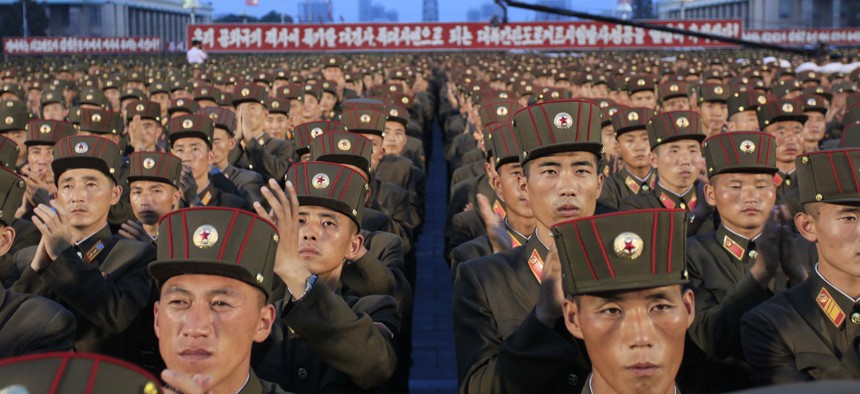
In this Thursday, July 6, 2017, file photo, soldiers gather in Kim Il Sung Square in Pyongyang, North Korea, to celebrate the test launch of North Korea's first intercontinental ballistic missile two days earlier. AP Photo/Jon Chol Jin
North Korea Appears to Have Launched Another Missile
Preliminary data suggest the test vehicle can travel farther than the ICBM launched earlier this month.
North Korea appears to have launched another missile, Japan and South Korea said Friday, an action that is likely to increase tensions with its neighbors and the U.S. and result in international pressure on Pyongyang over its missile and nuclear programs.
The test comes three weeks after North Korea tested an intercontinental ballistic missile (ICBM) that expert said could reach Alaska. At the time, experts said the missile had a range of about 7,000 kilometers.
Yoshihide Suga, Japan’s chief cabinet secretary, said Friday the projectile, believed to be a ballistic missile, was fired at 11:42 p.m. local time, flew for about 45 minutes, and landed in Japan’s exclusive economic zone. The Pentagon also confirmed the launch of what it called an ICBM, which it said traveled about 1,000 kilometers before splashing down in the Sea of Japan.
Jeffrey Lewis, who runs the website Arms Control Wonk, said on Twitter: “A 45 minute flight time means were looking at 10,000 km range missile, give or take,” which would mean today’s missile could fly farther than the one launched earlier this month. South Korea’s Joint Chiefs of Staff said the missile was launched from the northern Jagang Province. Recent tests have been from Kusong Province, which is southwest of Jagang. Yonhap, the South Korean news agency, reportedthe South Korean president convened an emergency security meeting over the test.
Melissa Hanham, a senior research associate at the Middlebury Institute of International Studies in Monterey, California, said that the data made public so far is preliminary, but if it holds, then the missile “flew much longer than their July 3 ICBM launch.”
The test wasn’t unexpected. News reports suggested North Korea was panning another test in the coming days. The test is North Korea’s 14ththis year, in line with its launches in recent years. Hahman said the reason for the North’s increased pace of testing is that a lot of new technology coming to fruition and Pyongyang is technically satisfied with some of their more simple missiles as well.
“This past year has been a combination of testing new technologies and practicing with the unit in the field,” she said. “I think they have just had a lot in the pipeline and it's all sort of coming together now.”
The launch came hours after the Japanese Cabinet approved additional sanctions against the North for its July 4 test of an ICBM, a move that violates its international obligations. The move was part of coordination international pressure on the North over its missile and nuclear programs. Earlier this month, the Trump administration also announced sanctions against the North, which included actions against Chinese banks that deal with the North. The Japanese sanctions announced Friday also target Chinese banks, which are seen as providing an economic lifeline to North Korea. South Korea meanwhile had tried another approach. President Moon Jae-in has called for closer ties with Pyongyang, and earlier this month offered talks with the North.
Any coordinated international action against North Korea will need the support of China and Russia, both veto-wielding members of the UN Security Council. While, in theory, the two countries say they support a denuclearized Korean Peninsula, they say their impact on the North is limited, and they want the U.S. to take steps they believe will allay some of North Korea’s security concerns. This is especially true of China, which provides the North with both political and economic support. Beijing says it has limited influence over Pyongyang’s behavior, and while that may be true, it’s also equally true that China has little incentive to change the status quo on the Korean Peninsula: The last thing Beijing wants is an ally, however unstable it is, be supplanted by a unified Korea that is pro-U.S.



